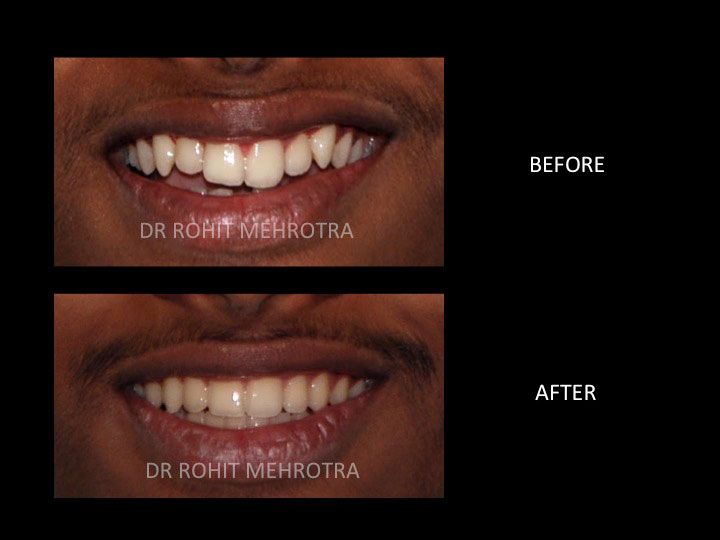Early orthodontics
A most common misconception is that orthodontic treatment is done only in the early teenage years once all the permanent teeth (other than wisdom teeth) have erupted into the oral cavity. The normal age by which all permanent teeth other than wisdom teeth erupt into the oral cavity is 11-13 years.
However, a number of orthodontic problems can be prevented from becoming severe or corrected very simply if treatment is instituted at an early age before all the milk teeth have fallen off.
Some of these problems include:
- Jaw growth discrepancy problems – As discussed earlier, the upper and/or lower jaw may be growing too much or too little or in an unfavorable direction which may be the chief cause of improperly positioned teeth or poor appearance. This can be detected in very initial stages by an orthodontist. Certain appliances can then be used to correct these growth problems. But these appliances are effective only during the active growth stage of the child. Especially in girls, jaw growth modification procedures should definitely be initiated by the age of 9-10 years or even earlier as most of their growth may be completed by the time all the permanent teeth erupt into the oral cavity. Treatment for problems like an excessively protruding chin is best initiated very early for both boys and girls (by 7 years of age in many cases) to achieve satisfactory results.
- Deterious habits like thumb and finger sucking, tongue thrusting and mouth breathing – These habits if allowed to persist lead to a progressively worsening appearance by having a deleterious effect on teeth position and jaw growth. Corrective measures which may include habit breaking appliances have to be instituted at an early age while some milk teeth are still present in these patients.
- Excessively protruding teeth predisposing to trauma – Excessive protrusion of the upper front teeth is a fairly common problem. Besides looking unsightly, if not corrected at an early age, these teeth are highly predisposed to trauma which may lead to breakage, fracture or loss of these teeth and therefore in some cases, it is recommended to correct these problems at an early age.
- For esthetic and psychosocial reasons – Certain malocclusions may make the child look unsightly. Such children often are the target of jokes and ridicule by other children. Teachers and other adults also frequently make the mistake of not taking them seriously. This lowers their self-esteem and affects their personality making them withdrawn developing a feeling of inferiority. In such situations, it is recommended to do early orthodontics to produce an improvement in the child’s appearance. This does wonder for his/ her confidence and self-esteem.
- To minimize chances of teeth extraction – To correct problems like severe crowding or protrusion, it is sometimes required to extract certain permanent teeth so that space can be created to properly position the remaining teeth and improve the patient’s appearance. Certain problems can be prevented from becoming severe if seen early and attended to in the mixed dentition years, thus reducing the chances of needing extractions in these cases.
The orthodontist is a professional specifically trained to recognize teeth and jaw problems at an early stage and prevent them from becoming severe. So we recommend that all children should have an orthodontic checkup by the age of 7 years to establish if they need treatment, and if so, the correct age to initiate it.
1 Phase vs. 2 phase Orthodontic Treatment
- Orthodontic treatment for children can be finished only once all the milk teeth have fallen off and their permanent successors have been positioned properly. This would normally happen not before the age of 12-13 years.
- For the comfort of the children, it is our endeavor to keep the duration of treatment as short as possible. Hence in most of the cases, orthodontic treatment is initiated once all the milk teeth have fallen off or are at the verge of falling off. So that the whole treatment can be finished in a single phase.
- However as mentioned above, for certain problems it is beneficial to institute treatment as early as 7-8 years of age. In such cases treatment is sometimes broken into 2 phases to prevent patients from getting fatigued or tired of the long treatment. The first phase is done in the mixed dentition years (when certain milk and certain permanent teeth are present) wherein orthodontic appliances are placed to obtain the benefits of early treatment. This may be done using fixed or removable appliances If the objectives of early orthodontics have been achieved and there is still some time before all milk teeth fall off, appliances may be discontinued or reduced to a minimum for some time to give the child a break or ‘ a holiday’ from the braces. Then the 2nd phase of treatment is instituted once the permanent teeth have erupted to place the teeth in their final positions. This is usually done using fixed appliances.
- The various types of orthodontic appliances that can be needed and used in the treatment of children and teenagers are discussed in detail in the section on “Types of orthodontic Appliances”.
Single phase orthodontic treatment.
A 13 year old boy with crowded teeth and defective occlusion (bite). Treatment for this patient was done in single-phase after all milk teeth had fallen off.
Two phase orthodontic treatment.
An eight-year-old boy reported with severe malalignment of teeth and anterior crossbite (lower front teeth biting ahead of uppers). The first phase of orthodontic treatment was done at age 8 yrs to correct the crossbite and lasted 3 months. The 2nd phase was done at age 13 after all milk teeth had fallen off to do full esthetic and occlusal (bite )correction and lasted 18 months.



